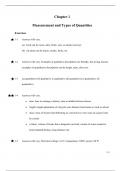Exam (elaborations)
Solutions Manual Physics: An Algebra-Based Approach 2nd Edition by Joanne O'Meara
- Module
- Institution
Solutions, Solutions Manual Physics, An Algebra-Based Approach 2nd Edition by Joanne O'Meara, Sarah Johnson, Ernie McFarland. chapters 1 to 24 solutions for Physics: An Algebra-Based Approach 2e.
[Show more]



